Why your hens lay outside of their nest
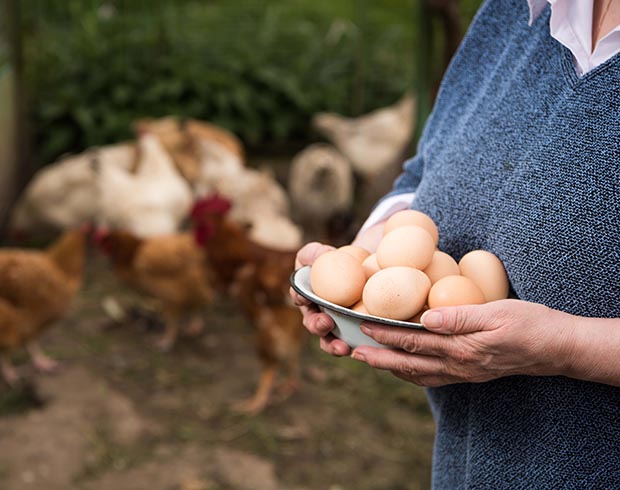
If you want your hens to lay eggs in the right place, the most basic requirement is a nest they’ll like over all others. But hens have some odd views on what they prefer.
Words: Sue Clarke
What does a hen look for in a nest? Its height from the ground? Whether it’s safe from predators? Its shape, the lining material, the seclusion from the flock, or something else?
As the collector of the eggs, what do you want in a nest? Ideally, it should be easy to access without too much bending or crawling, somewhere that is easy to keep manure and mite-free, somewhere that keeps the eggs safe, clean and unbroken.
To comply with all the needs both of the hen laying the egg and you as the egg collector, we need to look at quite a number of factors and sometimes reach a compromise between both hen and human
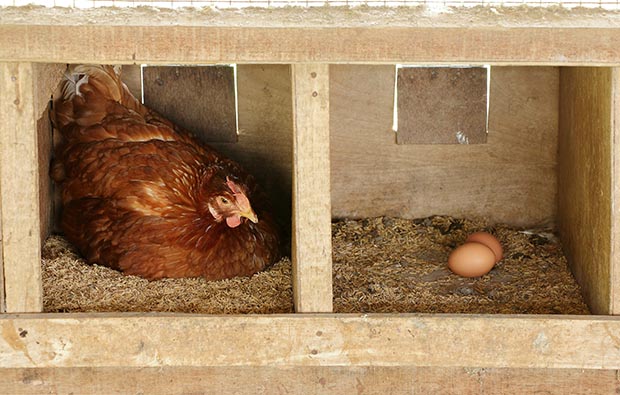
Hen in a wooden nesting box as she concentrates on laying an egg.
1. HOW MANY NESTS IS BEST?
The welfare code recommends a minimum of one nest to seven hens or 1m² of colony nest for 120 hens. But these are minimum standards and you’ll find it’s better to have at most 4-5 hens to one nest.
However, if you only have 4-5 hens, it is better to have at least two nests so that they have a choice, even if they all choose to lay in the same nest – more on that later.
2. SIZE OF NEST
This can vary because the size of nest for a small bantam varies quite a bit compared to what a large feathery Orpington needs. A 30cm wide x 35cm deep x 30cm high box, preferably with a roof and a 10-15cm lip at the front would suit most average-size birds.
3. POSITION IN THE COOP
Ideally, a nest box sits up off the floor at about the 50cm mark so you have floor space below for bird movement, while also giving some protection to the bird and her eggs from predators like hedgehogs and rats.
Hens like a perch rail set out in front so that they can walk along to view the nests before they decide which one to use. If you have this perch on hinges, it can do double duty and be folded up to block the nest entrance so birds can’t get into the habit of sitting in a nest box at night. It’s good training when birds are young to discourage birds from sleeping in the nests or roosting on the nest lip with heads out and bums in at night. It prevents them fouling the nest, and can also help to prevent mite build-ups.
The nest opening preferably needs to face away from any opening like a window in the coop to prevent bright light from shining into the nest. Too much light encourages other birds to vent peck when another bird is laying.
If the design of your coop doesn’t work, hang strips of black plastic, old feed sacks or some kind of easily-replaceable dark material along the front of the nests like a curtain which will help provide seclusion. If you have pullets just coming up to lay for the first time, keep the entrance curtain-free for a week or two until they have formed a habit of laying in the nesting area.
4. NEST LITTER
The obvious choice for many people is hay or straw, and that may be an economic choice you need to make. However, the best option is pine shavings, available in large bales from rural supply stores. A compressed fadge of shavings weighing 100kg costs about $80 and will last a long time.
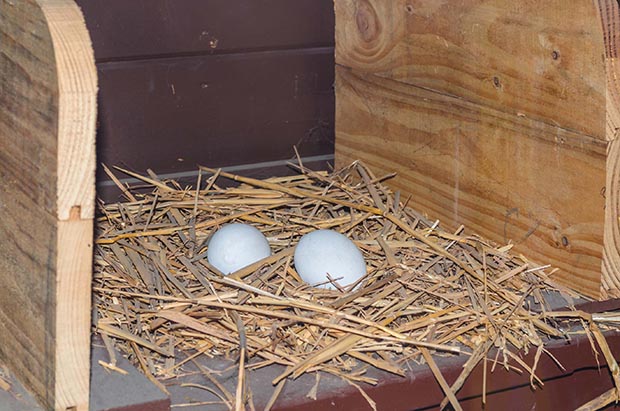
3 REASONS WHY SUE DOESN’T RECOMMEND HAY
Hay is probably the worst nest material in my opinion:
1. It can be damp and this encourages mould spores which can penetrate the pores of the shell when it is still warm and damp; if that egg is destined for hatching the fungal spores can also penetrate the embryo’s lung causing aspergillosis. Aspergillosis, known as farmer’s lung, can grow in human lungs too and that’s why it’s vital to wear a respirator and to mist water over the walls, floor and any bedding in a hen house before cleaning it as inhaling any dust puts you at risk.
2. Hay and straw can easily harbour mites inside the hollow stems
3. If you need to remove manure or broken eggs, it makes much more of a mess. However, for many people, hay or straw are the most economic options so I’d advocate you go for straw as it is more absorbent.
OTHER LITTERS TO CONSIDER:
• sawdust, which will stick to wet eggs but is easily rubbed off;
• shredded paper, which also sticks and can leave ink stains, but is easily removed;
• pine needles;
• artificial grass pads, initially more expensive but can be used long-term, and are removable and washable;
• specialist poultry supply firms have mats with rubber ‘fingers’ which are used in large colony nests and can be easily cleaned if soiled.
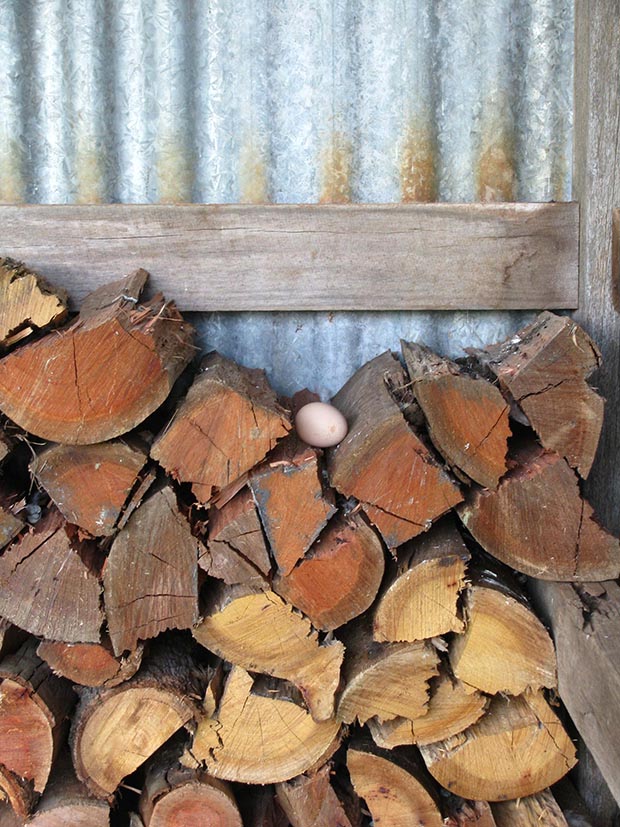
THE SCIENCE OF WHAT A HEN WANTS
Given all these options, some hens still make very peculiar decisions on what is the perfect nest site. In the wild a hen will leave the flock and go off into the undergrowth, often led by the rooster who will search out a spot for her which is why you sometimes see roosters in the nests, making a fuss so he can get his girls to come and have a look.
Hens will find a depression under some overhanging greenery (for shade and weather protection) where she feels she will be safe from prying eyes to brood and hatch her chickens.
In most breeds of domestic chickens, this urge to hide her nest is still high. The key to successfully persuading her that the nest boxes are best is to provide the ideal spot which is safe, dark and secluded or she will go off to find somewhere she thinks is better.
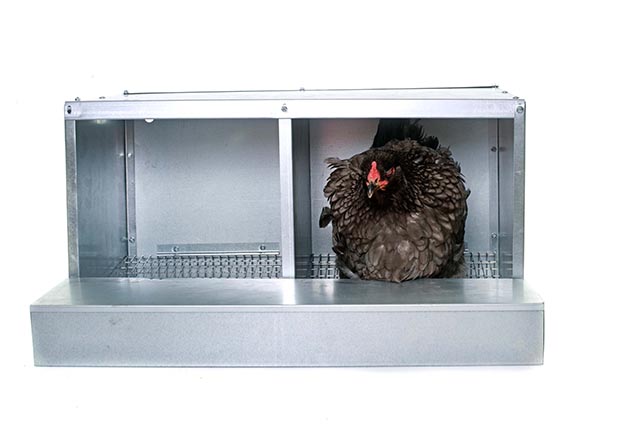
An example of a roll-away nest
A lot of research has been done into what shape, colour and size of nest a hen prefers as it’s important in large barn and free range flocks whether the egg collection is mechanised or carried out by manual means (human backs must be taken into account).
What scientists discovered is that hens prefer nests to be low to the ground; the compromise is 50cm, a workable height for a bending human. Birds also prefer unpainted metallic or wooden nests over black, blue green, yellow or red.
Inside, they prefer a concave bottom so they can snuggle in. This can be achieved by ensuring there is a generous lip along the front of the nest box and filling it with plenty of litter which enables them to mould a bowl shape in the shavings. If they can get their head down level with the lip so they are almost hiding behind it, they feel more comfortable too.
The ideal access perch should be flat not rounded, preferably wooden or metal (not plastic) and measure 8cm wide and 2cm deep.
Trials on nest hole shape used triangular, square and round openings. Although round was found to be quite well liked by hens, the constraints of manufacture on a large scale posed problems, unless large disposable cardboard tubes in a frame were obtainable. Round plastic buckets with a lip or half lid across the front might meet with approval.
PURPOSE-BUILT NESTS
There are a couple of options available in NZ for people that don’t want to build their own nest. These are especially well-designed to keep the eggs clean and safe. The best models are made out of steel so they can’t harbour mites, and the bottoms are angled so eggs roll away from the laying area so they’re safe from being trampled, messed on or eaten.
WHY EASE OF CLEANING IS A KEY CONSIDERATION IN NEST BOX DESIGN
When it comes to the egg, you’re dealing with a perishable food item, or perhaps that egg is going to become a vulnerable chick.
In both cases, cleanliness of the nest is a priority, so features that make a nest easy to clean are important as, despite your best efforts, birds will often work out a way to sleep and defecate in nests. The nests need to be easily cleaned, disinfected and treated for mites regularly. Metal or plastic is much easier to clean than wood and is not as attractive for mites to hide out in, although they will still colonise any joints.
Plastic bins or buckets will come into their own for ease of cleaning. If you have built-in nests, a removable bottom makes cleaning much easier.
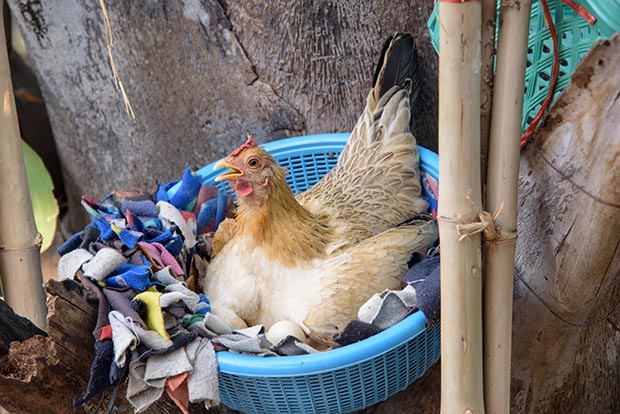
Hen egg pods in the basket.
Broken eggs in the nest can also cause a sticky mess and the presence of broken egg material encourages birds to scratch around in the nests to eat it, which can often break more eggs in the process. This is where wood shavings make spot cleaning on a daily basis much easier than hay as it absorbs the offending material in a contained blob, versus having to completely remove and probably wipe or wash down a nest containing hay.
Nests fixed to the wall create an added mite hideout behind it. Before you add litter to a nest box, give it a good spray inside, behind and around it with your choice of mite treatment. Continued treatment is crucial throughout the year to keep populations under control.
You could also add something like diatomaceous earth (DE) to the nest litter. Sprigs of aromatic herbs like lavender, rosemary and thyme may also help as the oils they contain are thought to be a mite deterrent.
CLEAN NEST BOXES ON A REGULAR BASIS
The remains of dried and dusty faeces and egg yolk, plus the added moisture from wet (freshly-laid) eggs and faeces make nest boxes the ideal medium for growing bacteria like salmonella, E. coli and campylobacter. It’s critical to clean out the whole nest on a regular basis, not just add fresh litter. A wet egg still has open pores through which bacteria can gain access as the warm contents shrink as they cool, creating a sucking effect on the egg’s exterior.
HOW TO TRAIN YOUR HENS
You’d think birds would find a nest by instinct and choose one you have so thoughtfully provided, but as many flock owners know, this is not always the case. Older birds laying and using the nests will attract the new layers, but you need to be prepared to spend time training them.
Some will start looking around their environment for a good spot even before they start to lay. A few artificial eggs (or golf balls or even lemons) in the nests might help. However their first egg may catch them unawares and it could be dropped anywhere in the coop or run. After that a hen will look for a proper place and will quickly become imprinted on this spot as the best place to lay. It can be very hard to change her mind.
If you can, move any ‘rogue’ eggs you find and place them in the nest, or place the bird in the nest as soon as you see her thinking about laying, or simply place a nest or suitable box where she has chosen to lay, put her in it and when she has laid there 2-3 days running, slowly move the nest to where you want it to be. This is easy if you are using buckets or individual boxes that are easily moved.
Think of the nest placement from the bird’s point of view. Can she see it when down on the ground, does it look dark and secluded enough, can she reach it easily and spend some time considering it by walking along a perch, rather than having to jump straight in from ground level?
Part of the training regime should be teaching them what you don’t want them to do. If you have young hens not yet laying, make sure they can’t sleep in the nest boxes as this is the start of a bad habit. Birds should perch or sleep on the floor at night, and it’s only broody hens who get to sleep on the nest. The best idea is to keep the nest boxes blocked off and only open them up about two weeks before eggs are anticipated.
You also want to discourage hens from using the lip of the nest as a perch. One way to train birds not to sleep in the nests once they are available, is to close them up in the late afternoon and only open them up again once it’s dark (eg, after dinner) so birds are already in the coop, sleeping on their perches. This way the nests are still available for the early morning layers.
Love this story? Subscribe now!
 This article first appeared in NZ Lifestyle Block Magazine.
This article first appeared in NZ Lifestyle Block Magazine.
